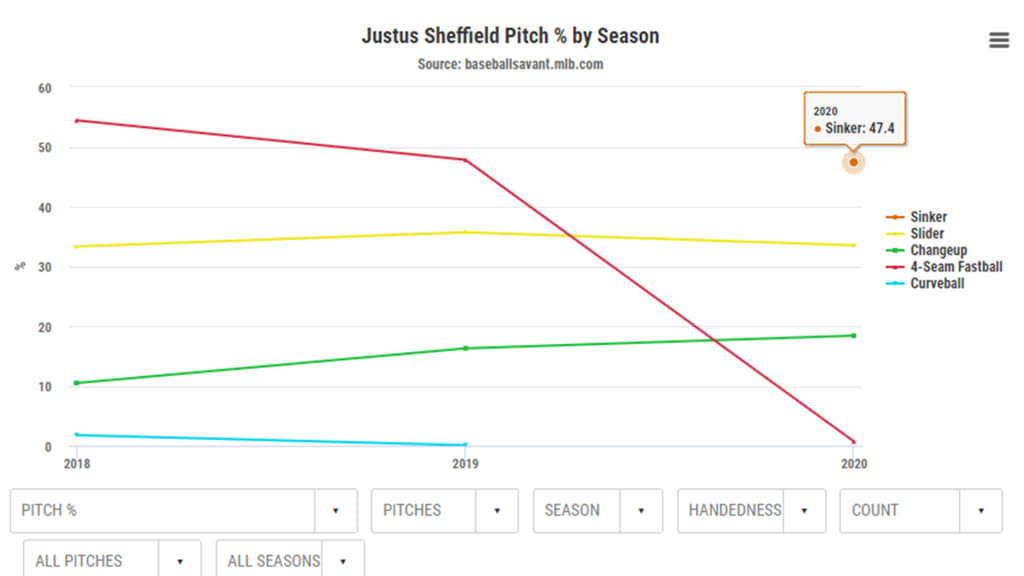There was never a true “aha!” moment for Justus Sheffield. It was more of a realization during the 2019 season when the left-hander acknowledged that his stuff alone wasn’t going to keep him in the Majors for good -- or, possibly, for long. But the awakening led to the biggest step forward of any pitcher on the Mariners’ staff in ‘20.
Sheffield enters 2021 an overhauled product from the bluechip Yankees prospect he was just three years ago, before he came to Seattle as the key return in the James Paxton trade after ’18. The stuff is essential to his makeup, but he’s injected far more finesse into his game. Taking a page from the similar-sized Marco Gonzales, Sheffield has put a far bigger premium on location than ever before.
“I just feel like what told me was not getting it done in the big leagues,” Sheffield said of when he realized he needed a changed approach. “I've always been told my stuff was good enough to get guys out, but there was one final key, and then obviously that was the location, being able to set hitters up and running in the game a little bit more as a pitcher.
“Marco really relies on location over his stuff, and that's something where watching him, I’ve kind of learned to put [it] into my game. I've always been stuff over location, and I'd gotten away with that early on in my career and through the Minors. But just watching him be able to put the ball where he wants to put it and set hitters up and watch him attack hitters, it's helped me a lot.”
Sheffield’s goal for 2021 is to pitch at least six innings in each start, a benchmark he reached six times in 10 outings last year. Only Gonzales, with seven, had more among Mariners pitchers.
Given that Sheffield is just 24 years old, never threw more than 133 innings in the Minors and -- like everyone else -- will be ramping up from a 60-game season to a marathon, he’ll be on an innings leash, probably no more than 140-150.
But some simple math suggests that Sheffield’s goal is somewhat within reason. First, the Mariners will proceed with a six-man rotation, which would allocate him fewer starts. Second, he’s become far more economical with his pitches, thanks in part to his revised, location-driven approach.
Sheffield: pitches per batter / per inning / % ahead in count / % first-pitch strikes
2018: 4.1 | 21.4 | 17.5% | 35.7%
2019: 4.0 | 18.7 | 27.2% | 62.5%
2020: 3.8 | 15.9 | 28.9% | 62.8%
Third, going six innings wire-to-wire probably won’t happen for any pitcher this season, but the possibility of going six innings more often than not is there.
“I know early on, they might have the ropes on us with the pitch count early on, but once we're fully going, I want to be out there for at least six innings,” Sheffield said. “I feel like that would be a good goal to accomplish this year.”
Sheffield has spent this offseason training back home in Tennessee with his brother, Jordan, who is in the Rockies' organization. His biggest objective has been honing the changeup that he began throwing more in 2020, which plays off the two-seam fastball that he started utilizing after ditching his four-seamer due to a lack of spin and swing-and-miss capability. Sheffield acknowledged that he needs to take the changeup a few ticks down from the high-80s to have a better velocity variance between the two.
The two-seamer (sinker) was a significant factor in his step forward last season, as it became his go-to pitch and he became more confident to throw the contact-prone offering over the plate because of the much-improved Mariners defense behind him. And he has one of the better sliders in the American League, with an opposing slugging percentage of just .219.

“When the confidence grew, then you started to see that now he's throwing a few more changeups,” Mariners manager Scott Servais said. “He's not just solely relying on the slider to put people away, which allowed him ultimately to get deeper into ballgames. I think one of the better stories of our season last year -- certainly it's hard to top what Kyle Lewis did -- but Sheff stepping up and doing what he did, you can dream on that one a little bit.”
There’s still a learning process in play. Failure can be such a focal part of a big leaguer’s development, especially pitchers. Sheffield has a much shinier résumé than one year ago after putting up numbers that probably merited some consideration for the AL Rookie of the Year Award, even if Lewis was the unanimous winner. He was 4-3 with a 3.58 ERA, a 118 ERA+ and worth 1.6 wins above replacement, per FanGraphs.
And there’s still self-recognition that his revised approach is one he’ll have to sustain over a much longer season, even on the tough days.
“You can't just go out there and think you're going to blow by heaters and then get guys out with sliders in the dirt every time,” Sheffield said. “That’s what I thought coming up. I think just getting out there, getting those reps in the big league games and growing and evolving and learning that location is huge. It’s key.”


